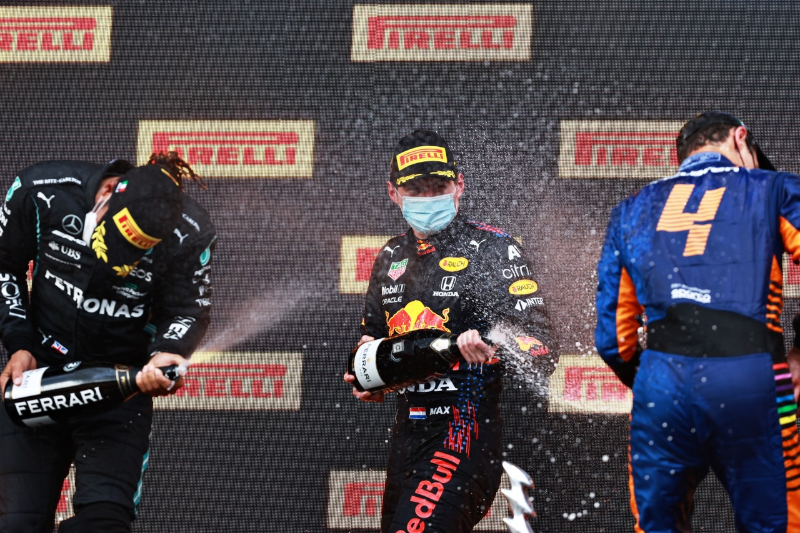Formula 1 is a high-octane, adrenaline-fueled motorsport that has captivated audiences worldwide, with its U.S. fan base surging in recent years, thanks in part to Netflix’s Formula 1: Drive to Survive. The championship spans from March to November, featuring races across Europe, Asia, the Americas, the Middle East, and Australia, held on a mix of permanent circuits, street tracks, and hybrids.
These events, known as Grand Prix (French for “big prize”), cover approximately 190 miles and last up to two hours. These cutting-edge cars, designed with unparalleled precision, hit speeds of up to 250 mph, enduring staggering levels of G-force, or gravitational force, during acceleration and impressive braking: 60mph to zero in about 1.5 seconds and 15 meters.
When the checkered flag waves and the race is won, the celebration is as legendary as the race itself. Much like the NFL’s Gatorade bath, F1 champions bask in a Champagne shower—because in Formula 1, victory is always worth celebrating with bubbles.
Niki Lang, Realtor and CEO of DC Motorsport Community, captures the unique synergy between Formula 1 and wine: “A long history, passion, and excellence are all key components in both Champagne and racing. The competition against oneself is what I believe drives racers and winemakers alike. Always pushing to create something better than before, no matter the circumstances you find yourself in.”
The Beginning of Champagne in Formula 1
The tradition of Champagne at Formula 1 races dates back to the 1950 French Grand Prix. Held at Reims-Gueux, a high-speed street circuit located just five miles west of Reims—the unofficial capital of Champagne—this event set the stage for a unique motorsport celebration. Juan Manuel Fangio, the race winner, was presented with a bottle of Moët & Chandon, marking one of the earliest instances of Champagne being associated with a sports victory and soon became standard practice at all races.
The iconic Champagne spray, however, didn’t make its motorsport debut until 1966 during the famous race widely known as the 24 Hours of Le Mans. After winning the Index of Performance class, Porsche drivers Jo Siffert and Colin Davis received a magnum of Champagne that had overheated in the sun. The increased pressure caused the cork to explode unexpectedly, drenching those nearby.
The following year, American driver Dan Gurney turned the accident into a deliberate act of celebration. After winning the Le Mans overall with co-driver A.J. Foyt, Gurney enthusiastically shook the bottle and sprayed it over everyone—fans, competitors, cameras, and even Madame Ford, the elegantly dressed wife of team owner Henry Ford II. The moment became legendary, cementing Champagne showers as a quintessential part of motorsport victories.
F1’s cultural crossovers extend beyond Champagne. Lang cites F1 driver Daniel Ricciardo’s DR3 x St Hugo wines as a personal favorite: “Their Coonawarra Cab is delicious! Ricciardo, known for his charisma, stole hearts on Drive to Survive. He created his own podium celebration, the Shoey—drinking Champagne from his race shoe—and even designed a wine decanter modeled after it: the Shoey decanter.”
Sponsorship Over the Years
As podium showers became a fixture, sponsorship offers poured in. Champagne was the pinnacle of victory in motorsports, and labels vied for the chance to take center stage on the F1 podium, driven by the sport’s explosive popularity in regions like the U.S., the Middle East, the Emirates, and Asia. The global reach of F1 made such partnerships a golden ticket for worldwide visibility.
Lang highlighted the value of aligning with F1: “Wine labels clearly benefit from associating with the F1 brand, especially with the sport’s increased focus on the U.S. market, which had been largely untapped. Netflix’s Drive to Survive has been instrumental in opening doors, making F1 accessible to a broader audience, particularly millennials.”
Over the years, several legendary Champagne houses have graced the F1 podium. Moët & Chandon, the first to supply Champagne for F1 winners, officially partnered with the series in 1966. This relationship lasted 33 years, the longest in F1 history, until G.H. Mumm took over in 2000, maintaining its reign until 2015.
In 2016, the championship broke with tradition by partnering with Chandon Argentina, a sparkling wine from Mendoza—the first non-Champagne to take the podium. Chandon’s tenure was brief, ending in 2017, when Champagne Carbon stepped in with its distinctive offerings.
In 2021, F1 partnered with Ferrari Trento, marking the first time an Italian producer supplied the celebratory bottles. Originally a three-year agreement, the partnership extended through 2025 due to its success. Ferrari Trento’s exports soared, doubling worldwide, and tripling in the U.S., particularly in states hosting Grand Prix events like Florida, Nevada, and Texas.
Starting in 2025, however, LVMH’s Moët & Chandon will reclaim its place on the podium, kicking off a historic ten-year deal. The partnership will debut at the Melbourne Grand Prix in March and extend beyond the podium, integrating LVMH brands into Formula 1 hospitality, activations, and exclusive content. Louis Vuitton, which has crafted the F1 trophy’s custom trunk for the past four years, will join Moët Hennessy and Tag Heuer in delivering a luxurious new chapter for F1 celebrations.
F1 and Champagne: A Perfect Pairing for Victory
The connection between Formula 1 and Champagne (and sparkling wine) is more than just a tradition—it’s a full-throttle celebration of excellence, precision, and the pursuit of greatness. Both blend artistry and luxury with just a dash of drama, creating a moment of triumph that bubbles over, quite literally, beyond the podium. For fans and drivers alike, it’s the ultimate victory drink—because nothing says “I’m the fastest person on the planet” like dousing yourself and everyone nearby in a shower of fizz.
Photo Courtesy of Ferrari Trento

